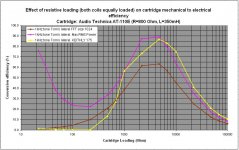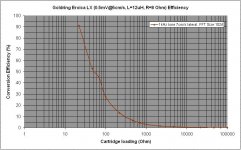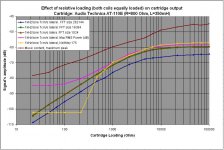dvv, I did not test any of my amps with DBT.
And yes, the sound of the amps as I write about them is just my say-so.
However, if you read my write-ups, I am very careful not to make subjective claims based on technical matters. So, like government, I keep 'church and state' completely separate. One issue is to do with the mind (technical) and the other with the heart (subjective). When the two disagree, only the judge (DBT) can settle it.
🙂
Andrew, I was not provoking anything, I am the man who wants to make his own sample of your amp. Obviously, I do not lack faith in your comments. I have trust in some say-sos. Occasionally, much more so than in DBT results. I have no trouble whatsoever that what you wrote was in good faith and that it is indeed so. My point was simply what you ackowledged yourself: sometimes, DBT is simply not felt to be necessary.
Same to you. Let's, happily, leave it here. I don't think we're as far apart philosophically as was being projected, unless you find Andrew's post between ours extremely objectionable. Even then, I'd still grab a beer with you at a pub and enjoy the conversation.
🙂
No, I do not, in fact I put my faith in Andrew's work to the point that I have started slowly gathering the bits and pieces for his preamp project. I'd hardly do that unless I trusted his integrity, right?
And yes, if that beer was changed into cider, I'd love to knock glasses with you. I am LONG beyond the point where disagreement on any single point is ever likely to be transferred to the person of the one I am disagreeing with. A bit too old for that, you know, 62 is 62, no matter what. By that age, one is expected to have gathtered at least some wisdom.
Last edited:
John, why don't you put this DBT thing to use instead of knocking it all the time?
If you can engineer an amp well that truly sounds different on a DBT against a reference, then you really have something unique.
Huh? Would be trivially easy to design an amp that truly sounds different.
se
Human perception is largely a periodic updating of a model, with a huge amount of assumption, and correction to make it "seem" to be real time (it's not and can't be - latency minimum is at least .2 seconds, even in life-and-death situations). A good analogy is the way DVD video compression works.
Audio testing based on real-time or linear models is fraught with peril. Fraught, I say!
All good fortune,
Chris
Audio testing based on real-time or linear models is fraught with peril. Fraught, I say!
All good fortune,
Chris
Scott and Ed
The way I thought as a good one for estimating mechanic to electric efficiency gives plausible results with an MM but close to the edge with an MC cartridge. (Edit: The Eroica is with Neo magnets 😀)
With both cartridges, efficiency seems to peak with an ohmic load equal to the coil’s impedance.
At the recommended loading (47k for AT-110E, 100R for Eroica LX), efficiency seems to be close to 25%
I measured the cartridge output through an AD620 either as an x1 buffer or as a x53 flat preamp.
Good resolution and SNR with tone tracks was achieved by low resolution FFT (1024points) analysis of the recording. With higher resolution FFT, the problem of multi point peaks (it’s the medium) makes comparison btn different recordings difficult.
George
The way I thought as a good one for estimating mechanic to electric efficiency gives plausible results with an MM but close to the edge with an MC cartridge. (Edit: The Eroica is with Neo magnets 😀)
With both cartridges, efficiency seems to peak with an ohmic load equal to the coil’s impedance.
At the recommended loading (47k for AT-110E, 100R for Eroica LX), efficiency seems to be close to 25%
I measured the cartridge output through an AD620 either as an x1 buffer or as a x53 flat preamp.
Good resolution and SNR with tone tracks was achieved by low resolution FFT (1024points) analysis of the recording. With higher resolution FFT, the problem of multi point peaks (it’s the medium) makes comparison btn different recordings difficult.
George
Attachments
Last edited:
...incorrect to say that you haven't heard anything about blind testing of speakers...
Stuart, context please, can we have a bit of context, I was discussing the lack of it here.
Hoping not to start up the firestorm again, can I point outn in ref to:
Ive not heard of anyone in years (maybe since Julian Hirsch?) who said that THD indicates much about perceived sound quality. Mostly its a check that the builder didn't screw up on an individual box The quoted "0.05%" would put you far to the extreme within the "believing instruments" folks! No challenge, just saying.Just as classic THD measurement results are meaninful to those who need their instruments to tell them what they are hearing, while to me anything below 0.05% becomes essnetially meaningless.
Stuart, context please, can we have a bit of context, I was discussing the lack of it here.
Note that not only have Toole and Olive's results been discussed extensively here, Earl Geddes participates actively and has discussed a great deal of his work on speakers here.
No the cartridge is itself the 1.3k + 700mHy. The loading was a mere 23.5k at high frequencies, just half of what it ought to be.
Ahh - got it - thanks.
Andrew, I was not provoking anything, I am the man who wants to make his own sample of your amp. Obviously, I do not lack faith in your comments. I have trust in some say-sos. Occasionally, much more so than in DBT results. I have no trouble whatsoever that what you wrote was in good faith and that it is indeed so. My point was simply what you ackowledged yourself: sometimes, DBT is simply not felt to be necessary.
I agree with your point: DBT is not always needed and as long as you enjoy the music and the sound, that's all that matters.
Hoping not to start up the firestorm again, can I point outn in ref to:
Ive not heard of anyone in years (maybe since Julian Hirsch?) who said that THD indicates much about perceived sound quality. Mostly its a check that the builder didn't screw up on an individual box The quoted "0.05%" would put you far to the extreme within the "believing instruments" folks! No challenge, just saying.
No firestorm from me: 0.05% (-66 dB) seems a safe enough low number. 🙂
Easy to answer-you:So you are offering to fix this problem for free as its sooooo easy? Or do you in fact not understand how tricky this is.
Bestof-souvenir
70% of the code is mine. a lot of original tools, including an very nice upload tool for photos, entirely automatic, an exif/XMP viewer that exists nowhere else, a system of vote to populate the 'best-of' gallery automatically...
or have a look to Accueil, and see the galleries. Did-you ever had seen such a tool, both a slideshow and a lightbox in once ?
Now, you probably will propose yourself to teach-me Javascript, Php, CSS3 and html 5 ? It will be a lot of fun for me because it is obvious you don't have the slightest idea of what you are talking of..
Last edited:
EDIT: Oh wait I see what you are saying. It probably does have that function based on the FFT, but I was thinking more of the traditional filters and rms voltmeter capability.
Knowing the history of AP's software, I would agree.
No firestorm from me: 0.05% (-66 dB) seems a safe enough low number. 🙂
Bill's Sousa demonstration validated my general lack of concern with ultra-low distortion, though it can be an interesting intellectual challenge to achieve it anyway. I can (and do) greatly admire the superb engineering evident in the Benchmark amp's performance while being cognizant that without peeking, people wouldn't be able to distinguish it from lesser amplifiers like Adcom or Parasound, or even my own little efforts.
Bill's Sousa demonstration validated my general lack of concern with ultra-low distortion, though it can be an interesting intellectual challenge to achieve it anyway. I can (and do) greatly admire the superb engineering evident in the Benchmark amp's performance while being cognizant that without peeking, people wouldn't be able to distinguish it from lesser amplifiers like Adcom or Parasound, or even my own little efforts.
Right--there are quite a few modestly priced (and suitably cheap on the used market!) amplifiers that are polite into impolite loads and push well below audibility. Comically mid-fi parts $$-wise where (most) sensible designers hang out.
But sometimes its just fun to read about the efforts/engineering of some to make amps that challenge outstrip distortion testing equipment. (Bucket list item for me post-defense)
That's why things like JCX's headphone amp (first one that came to mind) are awesome. It's utterly ridiculous in the best way possible. 🙂
Scott and Ed
The way I thought as a good one for estimating mechanic to electric efficiency gives plausible results with an MM but close to the edge with an MC cartridge. (Edit: The Eroica is with Neo magnets 😀)
George, it's been a while. I thought the conversation was about damping via motor assembly over a large range of frequencies. Like does driving a short do anything for a high frequency cantilever resonance.
Easy to answer-you:
Bestof-souvenir
Very good photographs
.......even if they do remind me of a certain French photographer!🙂
Homage
Alternatively, Im pretty sure I could make an amp that measures 0.05% but that most would agree sounded terrible.
By:
A crossover notch-like distortion at very low level (tens or hundreds of mV) in a 200W amp and then measure the THD at full power like in most specs. As in Geddes' criteria of distortion products which increase rapidly as level decreases
By:
A crossover notch-like distortion at very low level (tens or hundreds of mV) in a 200W amp and then measure the THD at full power like in most specs. As in Geddes' criteria of distortion products which increase rapidly as level decreases
- Status
- Not open for further replies.
- Home
- Member Areas
- The Lounge
- John Curl's Blowtorch preamplifier part II




